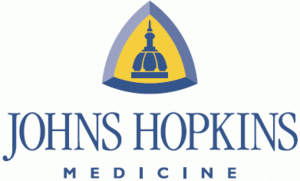Johns Hopkins Bloomberg School of Public Health
The Johns Hopkins Bloomberg School of Public Health funds the Rakai Project.[1] Johns Hopkins Bloomberg School of Public Health is part of the Health Communication Partnership[2], which is currently promoting circumcision in Uganda via mass media.[3]
Contents
Rakai Project
The Rakai Health Sciences Program (RHSP) is a program that began in 1987 in Uganda, Africa, to investigate the then-mysterious HIV.[4] The RHSP is headed by husband and wife team Ronald Gray & Maria Wawer (the Senior Principal Investigators),[5] who conduct biased research to look for justifications in rolling out mass circumcision programs around the world.[6] The RHSP is funded by the Johns Hopkins Bloomberg School of Public Health, the Uganda Virus Research Institute, the National Institutes of Health, and the Bill & Melinda Gates Foundation.[7][8]
History of the Rakai Project
The Rakai Project was created in 1987 by a group of scientists from Makerere University in Kampala, Uganda, who decided to investigate HIV infection in the Rakai district by initiating a small community cohort study. The original senior Principal Investigators of the Rakai Project were Nelson Sewankambo, David Serwadda, and Maria Wawer.[4] The Rakai Project has since changed its name to the Rakai Health Services Program, and has a current staff of just under 400 principal investigators, multidisciplinary professionals, and support staff.[4]
Promoting Circumcision as an HIV Prevention Method
The RHSP promotes mass circumcision as a means to prevent the spread of HIV. A Youtube video uploaded by the Johns Hopkins Bloomberg School of Public Health highlights the RHSP's mass circumcision program.[6]
| “ | Rakai Project Doctor Promotes Circumcision It's been hard to change policy because it's a whole new paradigm. We've never used surgery to prevent an infectious disease. Policy makers had to take some time to really wrap their minds around it. – Ronald Gray (Rakai Project. YouTube)[9] |
Circumcision Manual
In partnership with other WHO departments, UNAIDS, and the Department of Reproductive Health and Research (RHR), Johns Hopkins Program for International Education in Gynecology and Obstetrics (JHPIEGO) has developed a Manual for male infant circumcision under local anaesthesia.[10] The manual is intended for use by clinical officers, who can be trained to perform uncomplicated circumcision on infants, and to refer more complex cases. The manual is expected to be published in 2011. The manual itself is supported by training guides and a certification framework, to facilitate the upgrading of skills of officers who are not otherwise authorized to perform surgery.
Music Video
At the Rakai clinic, a propaganda music video promoting circumcision plays continuously in the waiting room.[11][12]
|
Original Research
Johns Hopkins did research[13] which showed circumcision offered a protective benefit against HPV. This was later debunked[14].
See also
External links
- Rakai Health Sciences Program home page at the Johns Hopkins Bloomberg School of Public Health.
 (2020).
(2020). HIV/AIDS
, Doctors Opposing Circumcision. Retrieved 16 July 2020.
References
- ↑

Rakai Health Sciences Program
. Retrieved 2 May 2011.
Quote:Celebrating 20+ Years of Public Health Research in Uganda
- ↑

HCP: Inspiring Voices Collective Action
. Retrieved 20 June 2011.
Quote:Johns Hopkins Bloomberg School of Public Health/Center for Communication Programs in partnership with Academy for Educational Development, Save the Children, The International HIV/AIDS Alliance, Tulane University School of Public Health and Tropical Medicine
- ↑
 Mirembe, Irene (19 June 2011).
Mirembe, Irene (19 June 2011). Embrace male circumcision to reduce HIV
, New Vision - Uganda's Leading Website. Retrieved 20 June 2011.
Quote:The writer works with Health Communication Partnership
- ↑ a b c
 Rakai Project.
Rakai Project. History of the Rakai Health Sciences Program
. Retrieved 2 May 2011. - ↑
 Rakai Project.
Rakai Project. Our People at Johns Hopkins University
. Retrieved 2 May 2011. - ↑ a b
 JohnsHopkinsSPH (10 January 2012).
JohnsHopkinsSPH (10 January 2012). Rakai Project
. - ↑
 Rakai Project.
Rakai Project. Rakai Health Sciences Program
. Retrieved 2 May 2011. - ↑
 Kong X (2011): Longer-term Effects of Male Circumcision on HIV Incidence and Risk Behaviors during Post-trial Surveillance in Rakai, Uganda. 18th Conference on Retroviruses and Opportunistic Infections (ed.). Boston, Massachusetts P. 36. Retrieved 2 May 2011. Acknowledgements slide Video of Presentation with Slides and Audio Download Link
Kong X (2011): Longer-term Effects of Male Circumcision on HIV Incidence and Risk Behaviors during Post-trial Surveillance in Rakai, Uganda. 18th Conference on Retroviruses and Opportunistic Infections (ed.). Boston, Massachusetts P. 36. Retrieved 2 May 2011. Acknowledgements slide Video of Presentation with Slides and Audio Download Link
- ↑ JohnsHopkinsSPH. (2010). Rakai Project. YouTube
- ↑
 World Health Organization, JHPIEGO (2010): Manual for early infant male circumcision under local anaesthesia. Geneva, Switzerland: WHO Document Production Services. ISBN 9789241500753. Retrieved 1 June 2011.
World Health Organization, JHPIEGO (2010): Manual for early infant male circumcision under local anaesthesia. Geneva, Switzerland: WHO Document Production Services. ISBN 9789241500753. Retrieved 1 June 2011.
- ↑
 JohnsHopkinsSPH (1 December 2010).
JohnsHopkinsSPH (1 December 2010). Rakai Project
. - ↑
 smugamba (10 June 2010).
smugamba (10 June 2010). Rakai male circumcision video by Stephen Mugamba feat Jemima Sanyu.mpg
. - ↑ http://www.thelancet.com/journals/lancet/article/PIIS0140-6736(10)61967-8/abstract
- ↑ http://intactnews.org/node/119/1314979135/circumcision-does-not-prevent-hpv-infection-rct-data-039inflated039-study-finds
